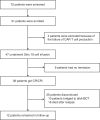Influence of patient characteristics on chimeric antigen receptor T cell therapy in B-cell acute lymphoblastic leukemia
- PMID: 33230103
- PMCID: PMC7683530
- DOI: 10.1038/s41467-020-19774-x
Influence of patient characteristics on chimeric antigen receptor T cell therapy in B-cell acute lymphoblastic leukemia
Abstract
CD19-specific chimeric antigen receptor T cell (CD19 CAR T) therapy has shown high remission rates in patients with refractory/relapsed B-cell acute lymphoblastic leukemia (r/r B-ALL). However, the long-term outcome and the factors that influence the efficacy need further exploration. Here we report the outcome of 51 r/r B-ALL patients from a non-randomized, Phase II clinical trial (ClinicalTrials.gov number: NCT02735291). The primary outcome shows that the overall remission rate (complete remission with or without incomplete hematologic recovery) is 80.9%. The secondary outcome reveals that the overall survival (OS) and relapse-free survival (RFS) rates at 1 year are 53.0 and 45.0%, respectively. The incidence of grade 4 adverse reactions is 6.4%. The trial meets pre-specified endpoints. Further analysis shows that patients with extramedullary diseases (EMDs) other than central nervous system (CNS) involvement have the lowest remission rate (28.6%). The OS and RFS in patients with any subtype of EMDs, higher Tregs, or high-risk genetic factors are all significantly lower than that in their corresponding control cohorts. EMDs and higher Tregs are independent high-risk factors respectively for poor OS and RFS. Thus, these patient characteristics may hinder the efficacy of CAR T therapy.
Conflict of interest statement
The authors declare that we have no financial and personal relationships with other people or organizations that can inappropriately influence our work. There is no professional or other personal interest of any nature or kind in any product, service, and/or company that could be construed as influencing the position presented in, or the review of, the paper entitled. We declare that no competing interests exist regarding the publication of this paper.
Figures






Similar articles
-
CD4+CD25+CD127low regulatory T cells associated with the effect of CD19 CAR-T therapy for relapsed/refractory B-cell acute lymphoblastic leukemia.Int Immunopharmacol. 2021 Jul;96:107742. doi: 10.1016/j.intimp.2021.107742. Epub 2021 May 11. Int Immunopharmacol. 2021. PMID: 33984717 Clinical Trial.
-
An analytical biomarker for treatment of patients with recurrent B-ALL after remission induced by infusion of anti-CD19 chimeric antigen receptor T (CAR-T) cells.Sci China Life Sci. 2016 Apr;59(4):379-85. doi: 10.1007/s11427-016-5035-4. Epub 2016 Mar 24. Sci China Life Sci. 2016. PMID: 27009300
-
Elevated CD10- neutrophils correlate with non-response and poor prognosis of CD19 CAR T-cell therapy for B-cell acute lymphoblastic leukemia.BMC Med. 2025 Mar 5;23(1):138. doi: 10.1186/s12916-025-03968-5. BMC Med. 2025. PMID: 40038688 Free PMC article.
-
Chimeric Antigen Receptor Therapy in Acute Lymphoblastic Leukemia Clinical Practice.Curr Hematol Malig Rep. 2017 Aug;12(4):370-379. doi: 10.1007/s11899-017-0394-x. Curr Hematol Malig Rep. 2017. PMID: 28656487 Review.
-
CAR therapy for hematological cancers: can success seen in the treatment of B-cell acute lymphoblastic leukemia be applied to other hematological malignancies?Immunotherapy. 2015;7(5):545-61. doi: 10.2217/imt.15.6. Immunotherapy. 2015. PMID: 26065479 Free PMC article. Review.
Cited by
-
Incidence of immune effector cell-associated neurotoxicity among patients treated with CAR T-cell therapy for hematologic malignancies: systematic review and meta-analysis.Front Neurol. 2024 Oct 15;15:1392831. doi: 10.3389/fneur.2024.1392831. eCollection 2024. Front Neurol. 2024. PMID: 39474369 Free PMC article.
-
A bi-specific CAR-T cell therapy targeting CD19 and CD22 in relapsed or refractory B-ALL.Clin Exp Med. 2025 Jul 28;25(1):264. doi: 10.1007/s10238-025-01637-8. Clin Exp Med. 2025. PMID: 40719826 Free PMC article. Clinical Trial.
-
Mechanisms of Immune Evasion in Acute Lymphoblastic Leukemia.Cancers (Basel). 2021 Mar 26;13(7):1536. doi: 10.3390/cancers13071536. Cancers (Basel). 2021. PMID: 33810515 Free PMC article. Review.
-
Case Report: Combined Intravenous Infusion and Local Injection of CAR-T Cells Induced Remission in a Relapsed Diffuse Large B-Cell Lymphoma Patient.Front Immunol. 2021 Apr 19;12:665230. doi: 10.3389/fimmu.2021.665230. eCollection 2021. Front Immunol. 2021. PMID: 33953727 Free PMC article.
-
Difference in Efficacy and Safety of Anti-CD19 Chimeric Antigen Receptor T-Cell Therapy Containing 4-1BB and CD28 Co-Stimulatory Domains for B-Cell Acute Lymphoblastic Leukemia.Cancers (Basel). 2023 May 15;15(10):2767. doi: 10.3390/cancers15102767. Cancers (Basel). 2023. PMID: 37345104 Free PMC article. Review.
References
Publication types
MeSH terms
Substances
Associated data
LinkOut - more resources
Full Text Sources
Medical

